
The best online fitness resource you'll ever need. We filter out the BS to ensure you meet your health and fitness goals!

The best online fitness resource you'll ever need. We filter out the BS to ensure you meet your health and fitness goals!

Embark on a transformative journey with our Shredded Workout Plan, a 12 week blueprint to your ultimate physique. This isn’t just fitness, it’s a metamorphosis into a chiseled, muscular masterpiece.
Each phase is a milestone, guiding you through muscle building and fat loss. But it’s not just about aesthetics, it’s about optimizing your metabolism and nutritional habits for lasting results.
This program demands sweat, dedication, and consistency. Your final form will be a unique testament to your hard work. Ready to embrace the challenge and reveal the shredded version of yourself?
Jump to the 12 week shred workout plan now!
Alternatively, you can download the free 12 Week Shredded Workout Plan PDF using the link below:
| Program style | Resistance training + HIIT |
| Program duration | 12 weeks |
| Workout duration | 20 mins – 1 hour |
| Scheduling | 5 days a week |
| Goal | Get shredded |
| Level | Beginners to advanced |
| Target Gender | Male and Female |
This “Get Shredded” program is aimed at those looking to attain and maintain their ideal beach body.
The program will run over 12 weeks and is split up into 3 distinct 4-week phases aimed at graduating through important milestones of muscle building and weight loss.
The main objectives are:
Fat loss will have the impact of improving general health and organ function especially where your cardiovascular health is concerned.
It also has the aesthetic role of revealing muscle definition, striations, and vascularity for that shredded look.
Increasing muscle mass has the health benefit of permanently optimizing your metabolism. That happens because muscle is an active tissue with a constant energy demand, even at rest. That means the fat you lose will be easier to keep off.
Building muscle also has the aesthetic value of increasing the impressiveness of your shredded appearance through optimized volume and definition.
This program will also teach you some essential nutritional principles such as the correct supplementation, protein targets, and macronutrient protocols.
Throughout the program, you will track your progress and adjust your workouts and nutrition plan accordingly.
By the end of the 12 weeks, you should have built a notable amount of lean muscle mass, shredded body fat, and sculpted a lean and defined physique.
Remember, simply having this program is not a guarantee for success, you need to put in the hard work and be consistent. You should also accept that your ideal body will be different from anyone else’s. What you will look like shredded is your own unique body profile based on your genetic makeup.
This program most certainly will help you lose weight. After all, the main consideration towards getting shredded is shedding body fat.
The principles and instructions in the program will primarily focus on fat loss objectives with muscle-building goals coming in at a close second.
That’s because it is possible to be shredded with a relatively low muscle mass as it is possible to have a high muscle mass while also carrying a significant amount of fat tissue.
With that said, weight loss in this regard is a delicate process and as you will learn from this program, will be carried out in a healthy and progressive way.
Extreme and sudden fat loss can have deleterious effects on your overall health and might even counteract goals.
In other words, the key is to get healthy, and by getting healthy, your body will transform into a lean mean beach ready machine.
Related: Try our 7-Day Keto Diet Plan for helping with the nutrition side of things.
This program is a 12 week progressive program split into three 4 week phases.
The phases are as follows:
| Phase | Period | Description |
|---|---|---|
| 1 | Weeks 1-4 | Build solid foundation |
| 2 | Weeks 5-8 | Shred fat |
| 3 | Weeks 9-12 | Sculpting and refining |
Phase 1: Building a Solid Foundation (Weeks 1-4):
Phase 2: Shredding Fat (Weeks 5-8):
Phase 3: Sculpting and Refining (Weeks 9-12):
For all phases, each week will comprise of a 5 day Upper Lower split with a day of cardio/HIIT training:
| Day | Split |
|---|---|
| 1 | Upper Body 1 |
| 2 | Lower Body 1 |
| 3 | Rest |
| 4 | Upper Body 2 |
| 5 | Lower Body 2 |
| 6 | Rest |
| 7 | Cardio/HIIT |
Overall, this program is structured to provide a challenging and effective workout that targets different muscle groups and includes a mix of cardio and strength exercises.
Each daily session will consist of the following elements in chronological order:
The warm up is a 5-10 minute session that includes a series of dynamic stretches and exercises to prepare your body for the main workout.
The warm up is designed to increase your heart rate, warm up your muscles, and prepare your body for the exercises.
| Dynamic Stretch (45 seconds) | How to Do It |
|---|---|
| Leg swings | Stand with your feet shoulder-width apart and swing one leg forward and back, then side to side, and finally in a circular motion. Repeat with the other leg. |
| Arm circles | Stand with your feet shoulder-width apart and extend your arms out to your sides. Make small circles with your arms, gradually increasing the size of the circles. |
| High knees | Stand with your feet hip-width apart and lift one knee up towards your chest, then lower it back down. Repeat with the other leg at a medium pace. |
| Butt kicks | Stand with your feet hip-width apart and kick one heel up towards your glutes, then lower it back down. Repeat with the other leg at a medium pace. |
| Walking lunges | Take a big step forward with one leg and lower your body down into a lunge position. Push off with your back foot and bring it forward to take another big step. Repeat for several reps. |
| Spiderman stretch | Start in a high plank position and bring one foot up to the outside of your hand. Hold for a few seconds, then switch sides. |
| Inchworms | Stand with your feet hip-width apart and bend forward, placing your hands on the ground. Walk your hands forward until you’re in a high plank position, then walk your feet forward to meet your hands. |
Each week, and depending on the day, you’ll have a combination of weight training and cardio workouts that are designed to challenge your body and help you achieve your goals. You’ll be using a variety of exercises, from compound movements like squats and deadlifts to isolation exercises like bicep curls and tricep extensions.
For resistance based exercises, choose a weight that allows you to complete the prescribed number of reps with good form. Increase the weight as you get stronger. We also specify a rest period in between sets, so please follow the prescribed times to allow your muscles to recover.
You’ll also be incorporating high-intensity interval training (HIIT) principles from our HIIT program to really boost your metabolism and burn fat. These workouts will be intense and straight to the point, so get ready to push yourself to the limit!
But let’s be real – working out is only half the battle. We’ll also be providing a nutrition section that is aimed at your goals and preferences. You’ll also be incorporating supplements like protein powder, BCAAs, and creatine to support muscle growth and recovery.
A cool down is an essential part of any workout, and it’s important not to skip it. After an intense workout, your body needs time to gradually return to its resting state. Here are a few reasons why a cool down is so important:
Below is your guide to an effective cool down strategy to be implemented at the end of each workout and should last 5-10 minutes.
| Stretch (hold for 30 seconds) | Target Muscles | How to Do It |
|---|---|---|
| Standing Hamstring Stretch | Hamstrings | Stand with feet hip-width apart and extend one leg forward, keeping it straight. Hinge forward at the hips and reach toward your toes. Hold for 30 seconds and switch sides. |
| Quad Stretch | Quadriceps | Stand with feet hip-width apart and bend one knee, bringing your heel toward your buttocks. Hold onto your ankle or foot with one hand and keep your knees close together. Hold for 30 seconds and switch sides. |
| Seated Forward Fold | Hamstrings and Lower Back | Sit on the floor with legs extended in front of you. Reach forward and try to touch your toes. Hold for 30 seconds. |
| Figure Four Stretch | Hips and Glutes | Lie on your back with knees bent and feet flat on the floor. Cross your left ankle over your right knee and gently pull your right knee toward your chest. Hold for 30 seconds and switch sides. |
| Shoulder Stretch | Shoulders and Upper Back | Stand with feet hip-width apart and reach one arm across your chest, using the other arm to gently pull it closer to your body. Hold for 30 seconds and switch sides. |
Remember, this cooldown program as well as the entire program in general should be carried out with special consideration to your physical limits and any underlying medical conditions.
If you suffer or have suffered from any injuries, disabilities or chronic conditions, or if you are recovering from surgery or on medication, make sure you get exercise readiness clearance from your physician or specialist before getting to work.
In order to maximize your exercise results, you will need access to a wide array of workout equipment, especially the type that engages resistance training.
This includes things such as:
Some additional equipment that may be helpful but not required include:
While it is possible to invest and set up your own gym, this is obviously beyond most people’s budgets or space allowance, so simply signing up or using an existing gym membership to access this equipment would be your best bet.
| Exercise | Week 1-2 | Week 3-4 | Rest |
|---|---|---|---|
| Bench Press | 3 x 8-10 | 4 x 8-10 | 60 sec |
| Bent Over Rows | 3 x 8-10 | 4 x 8-10 | 60 sec |
| Seated Dumbbell Shoulder Press | 3 x 8-10 | 4 x 8-10 | 60 sec |
| Cable Tricep Pushdowns | 3 x 12-15 | 4 x 8-10 | 60 sec |
| Bicep Curls | 3 x 12-15 | 4 x 8-10 | 60 sec |
| Exercise | Week 1-2 | Week 3-4 | Rest |
|---|---|---|---|
| Squats | 3 x 8-10 | 4 x 8-10 | 60 sec |
| Deadlifts | 3 x 8-10 | 4 x 8-10 | 60 sec |
| Leg Press | 3 x 12-15 | 4 x 8-10 | 45 sec |
| Leg Curls | 3 x 12-15 | 4 x 8-10 | 45 sec |
| Calf Raises | 3 x 12-15 | 4 x 8-10 | 45 sec |
| Exercise | Week 1-2 | Week 3-4 | Rest |
|---|---|---|---|
| Incline Bench Press | 3 x 8-10 | 4 x 8-10 | 60 sec |
| Lat Pulldowns | 3 x 8-10 | 4 x 8-10 | 60 sec |
| Seated Cable Rows | 3 x 12-15 | 4 x 8-10 | 45 sec |
| Dumbbell Flyes | 3 x 12-15 | 4 x 8-10 | 45 sec |
| Cable Bicep Curls | 3 x 12-15 | 4 x 8-10 | 45 sec |
| Exercise | Week 1-2 | Week 3-4 | Rest |
|---|---|---|---|
| Romanian Deadlifts | 3 x 8-10 | 4 x 8-10 | 60 sec |
| Lunges | 3 x 8-10 (per leg) | 4 x 8-10 (per leg) | 60 sec |
| Leg Extensions | 3 x 12-15 | 4 x 8-10 | 45 sec |
| Standing Calf Raises | 3 x 12-15 | 4 x 8-10 | 45 sec |
| Seated Calf Raises | 3 x 12-15 | 4 x 8-10 | 45 sec |
| Exercise | Week 1-2 | Week 3-4 |
|---|---|---|
| HIIT Workout: 30 seconds of high-intensity exercise (sprints, jumping jacks, etc.) followed by 30 seconds of rest. | 20-30 mins | 30-40 mins |
| Exercise | Week 5-6 | Week 7-8 | Rest |
|---|---|---|---|
| Incline Bench Press | 3 x 10-12 | 4 x 10-12 | 60 sec |
| Standing Dumbbell Shoulder Press | 3 x 10-12 | 4 x 10-12 | 60 sec |
| Cable Rows | 3 x 12-15 | 4 x 12-15 | 45 sec |
| Dumbbell Flyes | 3 x 12-15 | 4 x 12-15 | 45 sec |
| Cable Tricep Pushdowns | 3 x 12-15 | 4 x 12-15 | 45 sec |
| Exercise | Week 5-6 | Week 7-8 | Rest |
|---|---|---|---|
| Deadlifts | 3 x 10-12 | 4 x 10-12 | 60 sec |
| Leg Press | 3 x 10-12 | 4 x 10-12 | 60 sec |
| Walking Lunges | 3 x 12-15 (per leg) | 4 x 12-15 (per leg) | 45 sec |
| Leg Curls | 3 x 12-15 | 4 x 12-15 | 45 sec |
| Standing Calf Raises | 3 x 12-15 | 4 x 12-15 | 45 sec |
| Exercise | Week 5-6 | Week 7-8 | Rest |
|---|---|---|---|
| Bench Press | 3 x 10-12 | 4 x 10-12 | 60 sec |
| Lat Pulldowns | 3 x 10-12 | 4 x 10-12 | 60 sec |
| Seated Dumbbell Shoulder Press | 3 x 12-15 | 4 x 12-15 | 45 sec |
| Cable Bicep Curls | 3 x 12-15 | 4 x 12-15 | 45 sec |
| Cable Tricep Pushdowns | 3 x 12-15 | 4 x 12-15 | 45 sec |
| Lateral Raises | 3 x 12-15 | 4 x 12-15 | 45 sec |
| Exercise | Week 5-6 | Week 7-8 | Rest |
|---|---|---|---|
| Squats | 3 x 10-12 | 4 x 10-12 | 60 sec |
| Romanian Deadlifts | 3 x 10-12 | 4 x 10-12 | 60 sec |
| Leg Extensions | 3 x 12-15 | 4 x 12-15 | 45 sec |
| Seated Calf Raises | 3 x 12-15 | 4 x 12-15 | 45 sec |
| Standing Calf Raises | 3 x 12-15 | 4 x 12-15 | 45 sec |
| Exercise | Duration |
|---|---|
| HIIT Workout: 30 seconds of high-intensity exercise (sprints, jumping jacks, etc.) followed by 30 seconds of rest. | 30-40 mins |
| Exercise | Sets x Reps | Rest |
|---|---|---|
| Bench Press | 5 x 8-10 | 60 sec |
| Bent Over Rows | 5 x 8-10 | 60 sec |
| Seated Dumbbell Shoulder Press | 5 x 12-15 | 60 sec |
| Cable Tricep Pushdowns | 5 x 12-15 | 45 sec |
| Bicep Curls | 5 x 12-15 | 45 sec |
| Exercise | Sets x Reps | Rest |
|---|---|---|
| Squats | 5 x 8-10 | 60 sec |
| Deadlifts | 5 x 8-10 | 60 sec |
| Leg Press | 5 x 12-15 | 45 sec |
| Leg Curls | 5 x 12-15 | 45 sec |
| Calf Raises | 5 x 12-15 | 45 sec |
| Exercise | Sets x Reps | Rest |
|---|---|---|
| Incline Bench Press | 5 x 8-10 | 60 sec |
| Lat Pulldowns | 5 x 8-10 | 60 sec |
| Seated Cable Rows | 5 x 12-15 | 45 sec |
| Dumbbell Flyes | 5 x 12-15 | 45 sec |
| Cable Bicep Curls | 5 x 12-15 | 45 sec |
| Exercise | Sets x Reps | Rest |
|---|---|---|
| Romanian Deadlifts | 5 x 8-10 | 60 sec |
| Lunges | 5 x 8-10 (per leg) | 60 sec |
| Leg Extensions | 5 x 12-15 | 45 sec |
| Standing Calf Raises | 5 x 12-15 | 45 sec |
| Seated Calf Raises | 5 x 12-15 | 45 sec |
| Exercise | Duration |
|---|---|
| HIIT Workout: 30 seconds of high-intensity exercise (sprints, jumping jacks, etc.) followed by 30 seconds of rest. | 40-50 mins |
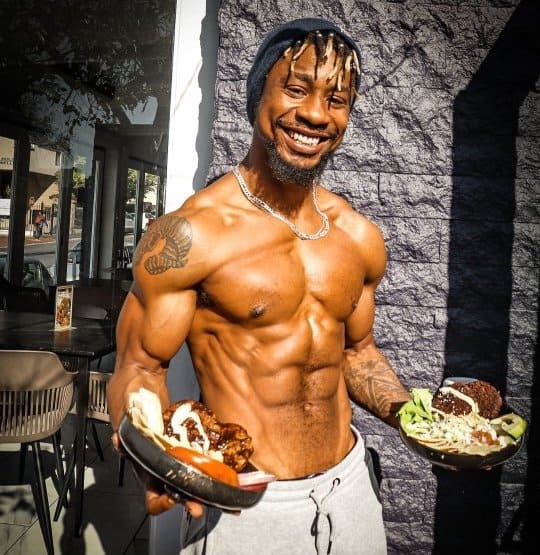
As mentioned, nutrition will be a key factor if not the main factor towards achieving a shredded physique.
Usually, it is best to approach nutrition from an individual to individual bases, but you aren’t getting a meal plan here, just a few useful and essential guidelines.
The first thing we need to look at is what you should be eating.
The most pivotal aspect of your nutrition when it comes to getting shredded is protein.
Protein uptake propels you to success in two ways. Firstly, it provides the building blocks to the muscle building component of your fitness goals. Secondly, protein helps you shed body fat.
The hypertrophic (muscle building) effect of protein means that it is contributing to an increased lean mass.
Increased lean muscle mass equals increased metabolic activity. Increased metabolic activity means higher instances of fat burning and lower instances of fat storage.
Protein is also highly satiating, which means it makes you fuller with less food and over a longer period than carbs or fat. That means you will escape cravings and hunger that would otherwise disrupt your caloric deficit.
Lastly, protein has a high thermic effect of digestion. This means your body requires more energy to digest protein than it does for fat and carbs. This contributes to your total energy expenditure and works in favor of your caloric deficit.
Aside from protein, aim for high quality food sources. That’s whole foods and minimally processed foods.
What we mean by minimally processed foods is foods who’s processing doesn’t detract from the nutritional integrity of the food.
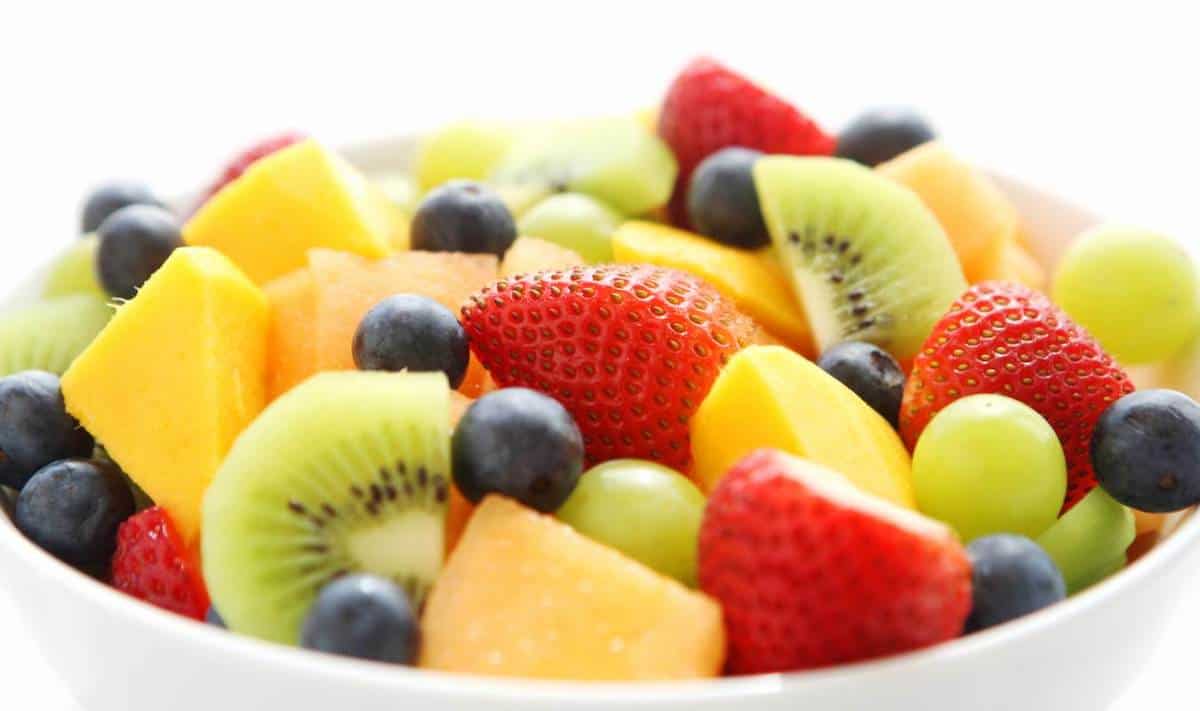
For instance, a fruit salad is an example of minimally processed fruit because you are still eating fruit in its whole form, just in smaller pieces. On the other hand, you can have 100% fresh fruit juice, which in our opinion is excessively processed.
That’s because juice extraction strips away the fiber and fruit solids, which are a major component to the nutritional quality of fruit.
With all that considered, just aim for a balanced diet with high quality natural, whole foods.
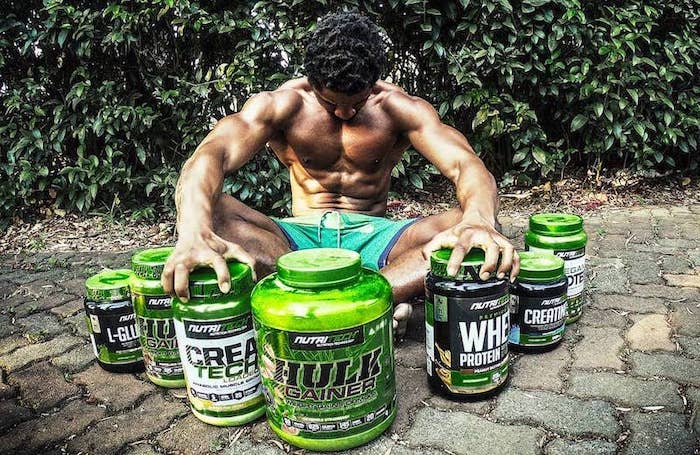
Supplements are often confusing to understand and hard to keep track of.
There are so many brands with so many products in their catalog with ranges of potency and flavors to choose from.
For instance, a single supplements brand can have 5 different pre workouts with different flavor and formula variations.
The truth is, most of the products in a supplements range are pretty useless. They aren’t typically bad for you, but most won’t provide any significant benefits except for the following:
Yes, you read right, only two supplements are considered essential.
We’ve already gone over the importance of protein, and that’s exactly why taking it in supplementally form will get you across the finish line and then some.
Then we have creatine, a supplement which is so well researched and valued for its benefits you can’t deny it’s place in your gym bag or supplements cupboard.
The biggest benefits of creatine supplementation are:
Research has shown that taking 5 grams of creatine per day can help increase muscle strength, power, and endurance, as well as improve overall exercise performance. It’s important to note that it may take several weeks of consistent use to see these benefits.
Some people choose to “load” with creatine by taking a higher dose (typically 20-25 grams per day) for the first 5-7 days in order to saturate their muscles with creatine more quickly. However, this method is not necessary and may cause gastrointestinal discomfort in some people.
It’s also important to drink plenty of water when taking creatine, as it can cause dehydration if you’re not adequately hydrated.
And when it comes to hydration, its essential to keep your fluid levels optimal. Not only is it vital for health, but having optimal hydration assists in muscle growth, function and aesthetic appearance.
Regarding pre-workout supplements, they are indeed effective, however, they aren’t essential and are easily substituted by cheaper, more available alternatives.
You see, the main component of a pre-workout formula is the stimulant, which is typically caffeine. Why not grab a coffee or green tea before your workout? You could place an argument for N02 boosters such as citrulline malate or lactic acid recyclers like beta-alanine which are common in pre-workout formulations.
Firstly, the research on these substances hasn’t fully concluded their efficacy, and even where effective, they are not significant game changers in the quality of your workouts. In other words, best to just stick to caffeine and creatine for your workout energy boost.
Citruline malate does have promising benefits, but it’s best to use it as a stand-alone supplement instead of consuming it as part of a pre-workout formula.
Then we have BCAAs, short for “branched-chain amino acids”
These 3 essential amino acids are found in all complete protein sources, which you should be consuming anyways if you want to get jacked.
So if you are already consuming BCAAs as part of your regular protein requirements, why should you take isolated supplemental doses?
Short story: if you are hitting your protein targets, you have more than enough BCAAs at your disposal.
The last supplement you don’t need is fat burners. These are either useless or slightly harmful.
They do little more than temporarily excite your heart rate, suppress your appetite, or flush out water from your body.
They have no direct impact or effect on fat stores in your body and the effect they do have which leads to weight loss is usually temporary and often not healthy.
One other supplement you should consider is NAC.
N-acetylcysteine (NAC) is a dietary supplement that has been studied for its potential health benefits.
It’s a precursor to glutathione, which is considered the most potent antioxidant in the body.
The reason this is so powerful is that oxidative stress is one of the stumbling blocks of a physique transformation.
Having a potent antioxidant such as glutathione from NAC ensures you can optimize your metabolism, keep your liver in check, and speed up recovery.
Overall, NAC is a versatile supplement with a variety of potential health benefits. However, as with any supplement in this program, it’s important to talk to your doctor before starting to take NAC, especially if you have any underlying health conditions or are taking any medications.
With a good idea of what to eat, it’s important to touch on the protocols and principles you should use to approach your diet.
Let’s start with protein again, and fortunately, this is a very simple guideline.
When it comes to protein consumption, the widely accepted protocol for the goals set out in this program is to consume 2g of protein for every 1kg of body mass.
That means for an active adult weighing 80kgs partaking in this shred program, they would need to consume up to 160gs of protein on a daily basis to hit the desirable resource quota for building muscle.
It can be difficult to smash this goal from your regular diet alone, and that’s why protein supplements are so essential.
How much food you consume during a shred program is tantamount to success. You need to deliberately enter a calorie deficit.
A calorie deficit occurs when you consume fewer calories than your body needs to maintain its current weight. This means that your body must use stored energy (in the form of fat or muscle) to make up the difference, resulting in weight loss. In order to lose 500g of body fat, you need to create a calorie deficit of approximately 3,500 calories.
This is another aspect where a high-protein diet comes into play. Protein plays a preservative role where your muscles are concerned. That’s because when you are in a significant caloric deficit, your body will likely burn muscle tissue as well as fat for energy.
In order to prevent your body from using amino acids from your muscle fibers, give it enough dietary protein to prevent that from happening.
With this taken care of, a calorie deficit is essential to a shred program because it is the most effective way to lose body fat.
When you create a calorie deficit, your body is forced to use stored energy (fat) to make up for the energy deficit. This results in a reduction in body fat, which is the goal of a shred program.
In order to create a calorie deficit, you need to consume fewer calories than your body needs. This can be done by reducing your calorie intake through diet, increasing your calorie expenditure through exercise, or a combination of both.
It’s important to note that a calorie deficit should be achieved through a moderate reduction in calorie intake and/or a moderate increase in calorie expenditure in order to avoid negative side effects such as muscle loss, fatigue, and metabolic damage, overtraining and just being miserable.
Extreme caloric deficits tend to lead to drastic relapses associated with yoyo dieting. Slow and steady wins the shreds.
Now let’s look at portion control.
It might seem a bit odd, but hand size portion control has been shown to fall in line with dietary requirements from individual to individual.
Hand size portion guidelines for Men are as follows:
Hand size portion guidelines for Women are as follows:
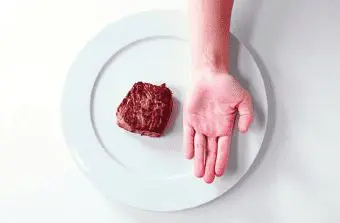
1 palm portion of protein dense foods with each meal
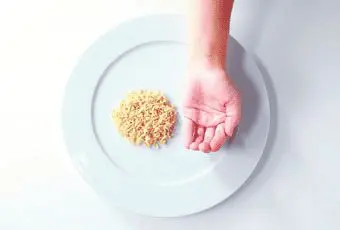
1 cupped handful of carb dense foods with each meal
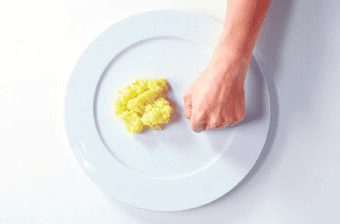
1 fist of vegetables with each meal
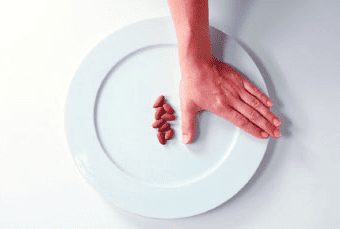
1 entire thumb of fat dense foods with most meals
Another helpful way of keeping track is through weight measurement of your macros and calculating your calories. Each of your macronutrients has an ideal intake guideline based on your physical profile. You’ll also have different caloric needs based on your level of activity. Let’s take a look at the info below.
| Macro Nutrient | grams/kg/day | kcal/gram |
|---|---|---|
| Protein | 2 | 4 |
| Fat | 0.75 | 9 |
| Carbs | 3 | 4 |
By following this program consistently while also implementing good nutrition and recovery habits, you are guaranteed to see significant changes over the 12 week period.
Just remember to focus on improving your own situation and avoid getting caught up in what other people have achieved r look like.
We all have unique bodies and metabolic systems.